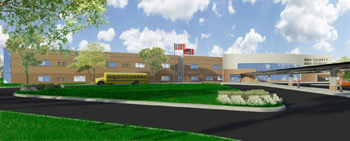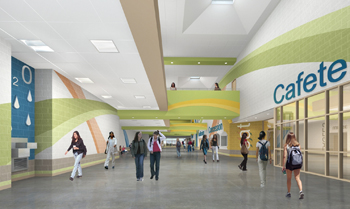School System Improves Multiple Programs with Updated Campus
 DAYTON, Tenn. — Students at Rhea County High School will have a new state-of-the-art building for the 2013-14 school year after construction work concludes on a new 230,000-square-foot structure. Meanwhile, renovation work on the existing 144,000-square-foot structure will be completed around the same time, creating a new middle school, which will lower the burden on local elementary schools and give sixth, seventh and eighth grade students their own space to experience the transition from childhood to becoming teenagers.
DAYTON, Tenn. — Students at Rhea County High School will have a new state-of-the-art building for the 2013-14 school year after construction work concludes on a new 230,000-square-foot structure. Meanwhile, renovation work on the existing 144,000-square-foot structure will be completed around the same time, creating a new middle school, which will lower the burden on local elementary schools and give sixth, seventh and eighth grade students their own space to experience the transition from childhood to becoming teenagers.
The new school was designed by Michael Brady Inc., based in Cleveland, Tenn., while Hewlett Spencer, LLC, out of Nashville, Tenn., served as the construction manager under a construction manager at-risk agreement.
The combined renovation and construction project, coming in at $30 million, will increase the capacity of the high school from 1,500 students to 2,000, along with improving facilities and adding a fire containment sprinkler system to the old structure. The renovation work also included upgrades to lighting systems and new ceilings, in addition to new paint on the exterior.
The new high school features a compact and efficient design with two gyms, the cafeteria and an auditorium located at the center of the structure, as opposed to being held in separate facilities, like in many older schools. Mike Brady, CEO at Michael Brady Inc. and lead designer on this project, explained this format drastically decreased the surface area of the external walls, by at least 30 percent compared to a standard school, which significantly increases the energy efficiency of the facility.
Centralizing these functions also created a more coherent feeling for the entrance of the school, which features a large two-story common space with high ceilings and a railing on the second floor, allowing students to look down over the entire area or gather and socialize before and after class. This common area also connects directly to the gyms and cafeteria, giving the school an open, organized and centralized feel.
Students will get to explore the new facilities early and often, as the school has a unique lunch schedule, where all students eat at one time and can take their meals anywhere they want.
As Brady explained, “The students have an hour to participate in lunch and extracurricular activities or exercise or counseling or journalism groups throughout the school. It’s really kind of a wild place at lunch, but it really is fun. It’s just a really positive environment. It takes quite a bit more kitchen and serving because you have to feed 2,000 students all at once.”
One popular eating location will most likely be the new auditorium, which has a variety of use and seating options.
“We did the auditorium where the first part of the floor is flat so they can have banquets in there and dances in there. Then we’ve got stadium seating so it gives a lot of flexibility and different ways to have fun in that auditorium, more uses for it,” Brady explained.
“We still have a regular full stage up there. That gives them a chance if they want to come out and extend that stage really simply or, if you want, to have a theatre in the round.”
The CEO added that the lines of vision were extremely good for all of these potential uses and “you can also come in there and do wrestling or volleyball even.”
Bill Steverson, principal at the design firm and project architect for this job, explained that wrestling was a very big sport in the local area and the school accordingly contains a large wrestling room with enough space for two mats, meaning multiple training matches can occur at once. The room also contains space for bleachers, allowing competitions or demonstrations to be held there.
“There’s also a weight training room inside the building that can be used by all the athletes, but it’s right there adjacent to the wrestling room and all the other locker rooms. They’ve also got separate locker rooms for track and cross-country and a coaches office area,” Steverson added.
Classrooms at the new facility are 9,000 square feet in size and contain a full wall of storage, along with a smart board.
“We have what we call a teacher technology control center where she can sit and network everything from her desk,” Stevenson explained.
The control center was designed with flexibility in mind, allowing the school to change out the technology hooked up to it as equipment and teaching styles evolve over time. Steverson added that the hallways had wiring for Internet that classrooms could tie into, but the school would mostly be wireless, with groups of servers spread throughout the facility. He said several computer labs were also included in the structure, located next to specific classroom clusters, meaning there are individual labs for math, English and foreign language studies.
 The school also includes an on-site nursery for teachers and other staff members with small children. The nursery is similar to the classroom spaces in size, but includes a small kitchenette and has a separate entranceway, which leads to a fenced-in play area.
The school also includes an on-site nursery for teachers and other staff members with small children. The nursery is similar to the classroom spaces in size, but includes a small kitchenette and has a separate entranceway, which leads to a fenced-in play area.
The existing structure continues to be used as a high school during the ongoing construction project, which is approximately 60 percent complete at this time. The two campuses were separated by fencing to keep students out of the construction site.
Most of the renovation work on the existing structures is being handled during the summer. “We worked just furiously during one summer period getting the sprinkler systems in place in what areas we could,” Brady explained.
The second and final summer of renovation work will begin this year and the project will be completed in time for the next school year.
“I think classes start the first week of August in the 2013-2014 school year so the teachers should have all of July, because the middle school teachers will also have to relocate into the new middle school. So the high school teachers will have to move out to the new high school,” Steverson explained.
